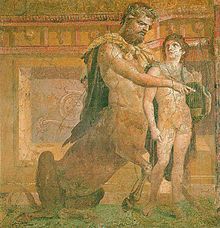- Chiron
-
This article is about the Greek mythological character. For other uses, see Chiron (disambiguation).
In Greek mythology, Chiron (/ˈkaɪrən/; also Cheiron or Kheiron) (Greek: Χείρων; "hand"[1]) was held to be the superlative centaur among his brethren.
Contents
History
Like the satyrs, centaurs were notorious for being wild and lusty, overly indulgent drinkers and carousers, given to violence when intoxicated, and generally uncultured delinquents. Chiron, by contrast, was intelligent, civilized and kind, but he was not related directly to the other centaurs.[2] He was known for his knowledge and skill with medicine. According to an archaic myth[3] he was sired by Cronus when he had taken the form of a horse[4] and impregnated the nymph Philyra,[5] Chiron's lineage was different from other centaurs, who were born of sun and raincloud, rendered by Greeks of the Classic period as from the union of the king Ixion, consigned to a fiery wheel, and Nephele ("cloud"), which in the Olympian telling Zeus invented to look like Hera. Myths in the Olympian tradition attributed Chiron's uniquely peaceful character and intelligence to teaching by Apollo and Artemis in his younger days.
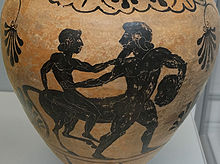 Amphora suggested to be Achilles riding Chiron. British Museum ref 1956,1220.1 .
Amphora suggested to be Achilles riding Chiron. British Museum ref 1956,1220.1 .
Chiron's haunts were on Mount Pelion; there he married the nymph Chariclo who bore him three daughters, Hippe (with a daughter Melanippe, the "Black Mare" or Euippe, "truly a mare"), Endeis, and Ocyrhoe, and one son Carystus.
A great healer, astrologer, and respected oracle, Chiron was said to be the first among centaurs and highly revered as a teacher and tutor. Among his pupils were many culture heroes: Asclepius, Aristaeus, Ajax, Aeneas, Actaeon, Caeneus, Theseus, Achilles, Jason, Peleus, Telamon, Perseus, sometimes Heracles, Oileus, Phoenix, and in one Byzantine tradition, even Dionysus: according to Ptolemaeus Chennus of Alexandria, "Dionysius was loved by Chiron, from whom he learned chants and dances, the bacchic rites and initiations."[6]
Death
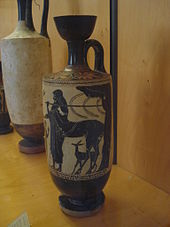 A lekythos depicting Chiron and Achilles
A lekythos depicting Chiron and Achilles
His nobility is further reflected in the story of his death, as Prometheus sacrificed his life, allowing mankind to obtain the use of fire. Being the son of Cronus, a Titan, he was immortal and so could not die. So it was left to Heracles to arrange a bargain with Zeus to exchange Chiron's immortality for the life of Prometheus, who had been chained to a rock and left to die for his transgressions.[7] Chiron had been poisoned with an arrow belonging to Heracles that had been treated with the blood of the Hydra, or, in other versions, poison that Chiron had given to the hero when he had been under the honorable centaur’s tutelage. According to a Scholium on Theocritus,[8] this had taken place during the visit of Heracles to the cave of Pholus on Mount Pelion in Thessaly when he visited his friend during his fourth labour in defeating the Erymanthian Boar. While they were at supper, Heracles asked for some wine to accompany his meal. Pholus, who ate his food raw, was taken aback. He had been given a vessel of sacred wine by Dionysus sometime earlier, to be kept in trust for the rest of the centaurs until the right time for its opening. At Heracles' prompting, Pholus was forced to produce the vessel of sacred wine. The hero, gasping for wine, grabbed it from him and forced it open. Thereupon the vapours of the sacred wine wafted out of the cave and intoxicated the wild centaurs, led by Nessus, who had gathered outside. They attacked the cave with stones and fir trees. Heracles was forced to shoot many arrows (poisoned with the blood of the Hydra) to drive them back. During this assault, Chiron was hit in the thigh by one of the poisoned arrows. After the centaurs had fled, Pholus emerged from the cave to observe the destruction. Being of a philosophical frame of mind, he pulled one of the arrows from the body of a dead centaur and wondered how such a little thing as an arrow could have caused so much death and destruction. In that instant, he let slip the arrow from his hand and it dropped and hit him in the hoof, killing him instantly. This, however, is open to controversy, because Pholus shared the "civilized centaur" form with Chiron in some art images, and thus would have been immortal.
Ironically, Chiron, the master of the healing arts, could not heal himself, so he willingly gave up his immortality. He was honoured with a place in the sky, for the Greeks as the constellation Centaurus.
Chiron saved the life of Peleus when Acastus tried to kill him by taking his sword and leaving him out in the woods to be slaughtered by the centaurs. Chiron retrieved the sword for Peleus. Some sources speculate that Chiron was originally a Thessalian god, later subsumed into the Greek pantheon as a centaur.<citation needed?>
Ovid tells us[9] another version of Chiron's death. In this version both Chiron and his student (see below) Achilles are in the cave on Mt. Pelion with Hercules. When Chiron admires the weapons of the mighty hero, Achilles is temped to touch them making one of the arrows fall and strike the left foot of the Centaur. Achilles cried, as he would for his father, as Chiron left for the skies.
Students
- Achilles - When Achilles' mother Thetis left home and returned to the Nereids, Peleus brought his son Achilles to Chiron, who received him as a disciple, and fed him on the innards of lions and wild swine, and the marrow of she-wolves.
- Actaeon - Actaeon, who was bred by Chiron to be a hunter, is famous for his terrible death; for he, in the shape of a deer, was devoured by his own dogs. The dogs, ignorant of what they had done, came to the cave of Chiron seeking their master, and the Centaur fashioned an image of Actaeon in order to soothe their grief.
- Aristaeus - The Muses were, according to some, those who taught Aristaeus the arts of healing and of prophecy. Aristaeus discovered honey and the olive. After the death of his son Actaeon he migrated to Sardinia.
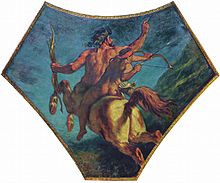 The Education of Achilles, by Eugène Delacroix
The Education of Achilles, by Eugène Delacroix
- Asclepius - The great healing power of Asclepius is based on Chiron's teaching. Artemis killed Asclepius' mother Coronis, on Apollo's orders, while still pregnant but snatched the child from the pyre, bringing him to Chiron who reared him and taught him the arts of healing and hunting.
- Jason - In an early tradition,[10] Aeson gave his son Jason to the Centaur Chiron[11] to rear at the time when he was deposed by King Pelias. Jason is the captain of the Argonauts.
- Medus - Medus, who some call Polyxenus and others Medeus, is the man after whom the country Media was called. He was the son of Medea by Aegeus.[12] Med[e]us died in a military campaign against the Indians.
- Patroclus - Patroclus' father left him in Chiron's cave, to study, side by side with Achilles, the chords of the harp, and learn to hurl spears and mount and ride upon the back of genial Chiron.
- Peleus - Peleus, father of Achilles, was once rescued by Chiron: Acastus, son of Pelias, purified Peleus for having killed (undesignedly) his father-in-law Eurytion. However, Acastus' wife, Astydameia, fell in love with Peleus, and as he refused her she intrigued against him, telling Acastus that Peleus had attempted to rape her. Acastus would not kill the man he had purified, but took him to hunt on Mount Pelion. When Peleus had fallen asleep, Acastus deserted him, hiding his sword. On arising and looking for his sword, Peleus was caught by the centaurs and would have perished, if he had not been saved by Chiron, who also restored him his sword after having sought and found it. Chiron arranged the marriage of Peleus with Thetis,[13] bringing Achilles up for her. He also told Peleus how to conquer the Nereid Thetis who, changing her form, could prevent him from catching her. In other legends, it was Proteus who helped Peleus. When Peleus married Thetis, he received from Chiron an ashen spear, which Achilles took to the war at Troy. This spear is the same with which Achilles healed Telephus by scraping off the rust.
The Precepts of Chiron
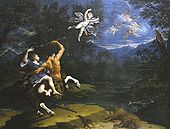 The Education of Achilles by Donato Creti, 1714 (Musei Civici d'Arte Antica, Bologna)
The Education of Achilles by Donato Creti, 1714 (Musei Civici d'Arte Antica, Bologna)
A didactic poem, Precepts of Chiron, part of the traditional education of Achilles, was considered to be among Hesiod's works by some of the later Greeks, for example, the Romanized Greek traveller of the 2nd century CE, Pausanias,[14] who noted a list of Hesiod's works that were shown to him, engraved on an ancient and worn leaden tablet, by the tenders of the shrine at Helicon in Boeotia. But another, quite different tradition was upheld of Hesiod's works, Pausanias notes, which included the Precepts of Chiron. Apparently it was among works from Acharnae written in heroic hexameters and attached to the famous name of Hesiod, for Pausanias adds "Those who hold this view also say that Hesiod was taught soothsaying by the Acharnians." Though it has been lost, fragments in heroic hexameters that survive in quotations are considered to belong to it.[15] The common thread in the fragments, which may reflect in some degree the Acharnian image of Chiron and his teaching, is that it is expository rather than narrative, and suggests that, rather than recounting the inspiring events of archaic times as men like Nestor[16] or Glaucus[17] might do, Chiron taught the primeval ways of mankind, the gods and nature, beginning with the caution "First, whenever you come to your house, offer good sacrifices to the eternal gods". Chiron in the Precepts considered that no child should have a literary education until he had reached the age of seven.[18] A fragment associated with the Precepts concerns the span of life of the nymphs, in the form of an ancient number puzzle:
A chattering crow lives out nine generations of aged men, but a stag's life is four times a crow's, and a raven's life makes three stags old, while the phoenix outlives nine ravens, but we, the rich-haired Nymphs, daughters of Zeus the aegis-holder, outlive ten phoenixes."[19]
In human terms, Chiron advises, "Decide no suit, until you have heard both sides speak".
The Alexandrian critic Aristophanes of Byzantium (late 3rd-early 2nd century BCE) was the first to deny that the Precepts of Chiron was the work of Hesiod.[20]
Cultural adaptations
- Chiron was featured in Dante Alighieri's Inferno. He led the centaurs in Hell's Circle of Violence where they fired their arrows at any of the damned that tried to escape from the Phlegethon.
- John Updike's novel The Centaur is an expansion and interpretation of the story of Chiron, set in the context of 20th century small-town America.
- Chiron is also a main character in the Percy Jackson & the Olympians series by Rick Riordan.
Use as a symbol
Chiron appears on the cap badge of the Royal Army Veterinary Corps and also appeared on a similar badge worn by the Royal Canadian Army Veterinary Corps. Chiron is the official mascot of the Delta Lambda Phi national social fraternity. Chiron is also the centerpiece in the logo of the American College of Veterinary Surgeons.[21]
The centaur logo of Remy Martin cognac depicts Chiron.
References
- ^ Compare the dactyls, "fingers", ancient masters of the art of metallurgy and magical healers.
- ^ Homer, Iliad xi.831.
- ^ A quote from the lost Titanomachia, provided as a scholium on Apollonius Rhodius' Argonautica I.554 (on-line quote); pseudo-Apollodorus Bibliotheke 1. 8 - 9, may have drawn upon the same source.
- ^ Compare the stallion-Poseidon who sired the steed Arion upon Demeter.
- ^ Bibliotheke 1.2.4; additional classical sources on-line
- ^ "Ὡς Διόνυσος ἐρώμενος Χείρωνος, ἐξ οὗ καὶ μάθοι τούς τε κώμους καὶ τὰς βακχείας καὶ τὰς τελετάς." (Ptolemaeus Chennus, New History, quoted in Photios of Constantinople, Library, 190.
- ^ Pseudo-Apollodorus, Bibliotheke, ii.5.4.
- ^ Theocritus, Idyll vii.149
- ^ Ovid,Fasti, V.389
- ^ Fragment (13) of the Hesiodic Catalogue of Women (Theoi.com| on-line text in translation).
- ^ Pindar Third Nemean Ode, 54
- ^ Hesiod, Theogony 993: She "bore a son Medeus whom Cheiron the son of Philyra brought up in the mountains."
- ^ Pindar, Eighth Isthmian Ode, 41.
- ^ Pausanias, ix.31.4-5.
- ^ H.G. Evelyn-White, tr. Hesiod II: The Homeric Hymns and Homerica (Loeb Classical Library 503), 2nd ed. 1936:73-.
- ^ In both Iliad and Odyssey.
- ^ In Iliad vi.155–203.
- ^ Fragment 4. The education of a girl was not considered. A literary education, in the sense of study of written texts, could not have been possible in the time of Hesiod himself, in the late eighth century BCE.
- ^ Precepts of Chiron, fr. 3
- ^ Evelyn-White 1936, fr. 4.
- ^ ACVS website.
External links
Categories:- Asclepius in mythology
- Centaurs
- Thessalian mythology
- Pederastic heroes and deities
Wikimedia Foundation. 2010.

